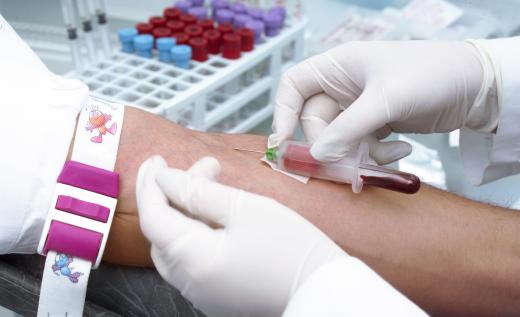What is the ELISA Procedure?
 Mary McMahon
Mary McMahon
The ELISA procedure is a procedure used to perform an enzyme-linked immunosorbent array (ELISA), a test which can be used to identify the presence of specific proteins and to determine their concentrations. There are actually a number of different procedures which can be used for an ELISA test, including direct, indirect, and so-called “sandwich” procedures. In all cases, the ELISA procedure is performed in a lab under controlled conditions to minimize the risk of false results.
In order to conduct an ELISA test, it is necessary to have a sample such as blood. A common reason to conduct an ELISA is to test for exposure to an infectious agent, in which case the sample in question may or may not have a specific protein, and the test is conducted to look for that protein. The test can also be used to check the concentration of a protein.

To conduct the test, a device called a microtiter plate is often used. Fans of medical and crime dramas are probably familiar with microtiter plates; they look like little trays with a number of inserts, each of which holds a vial. In the sandwich ELISA procedure, the technician starts by coating the vials with a known antigen in a known concentration, and then washing them with a buffer solution. Next, a serum made from a patient sample washed in the same buffer solution is added.

If the patient has antibodies to the antigens already in the tubes, they will stick to the sides of the tubes. The next step in the ELISA procedure involves the introduction of the same antigen, tagged with an enzyme, to the tubes. The antigen locks to the antibodies which have stuck to the sides of the tubes. The enzyme fluoresces or changes color, allowing the technician to see that the serum had antibodies which locked to the antigens, and to determine the concentration, on the basis of the intensity of the enzyme reaction.

An ELISA procedure is very sensitive and extremely precise, with technicians using very specific antigens to make sure that they identify the right antibodies, or vice versa, depending on what kind of test is being conducted. However, false positives do happen. In an example of a false positive, ELISA testing is commonly used to check for signs of HIV exposure, and it sometimes yields a false positive because the solution may bind to a protein associated with HIV which some people have without being infected. This is why a positive must be confirmed with a Western Blot.
AS FEATURED ON:
AS FEATURED ON:
















Discussion Comments
I took an ELISA allergy detection test and I'm so impressed. They only needed a sample of blood and afterward they gave me a list of foods I was allergic to. Ever since I've avoided those foods, my acne has completely disappeared!
@feruze-- Yea, if the person was just infected, the ELISA protocol will likely give a false negative but that's why they do the test after three months and repeat it if necessary.
ELISA is mostly used for testing HIV and it is recommended that the test be done at least three months after potential infection risk. This solves the issue of getting a false negative. If the test shows positive, then another ELISA and then a Western Blot is done to confirm the results.
I think ELISA is a good initial test to check for diseases and it's easy. If it's necessary, there are plenty of supporting tests that can be done.
I'm a little confused about the ELISA assay, it doesn't make much sense to me. From what I understand, in an ELISA, technicians look for antibodies to a specific virus to figure out if that person has been infected or not. Because if they are infected, their body will have produced antibodies to that virus. But why are we looking for the antibody? Why don't we just look for the virus itself?
I don't think this is a very good way of testing for diseases. I'm sure it takes the body some time to produce antibodies, right? I mean, I don't think it happens overnight. So what if someone is infected but their body hasn't produced antibodies yet? Then the ELISA would give a false negative wouldn't it?
Post your comments